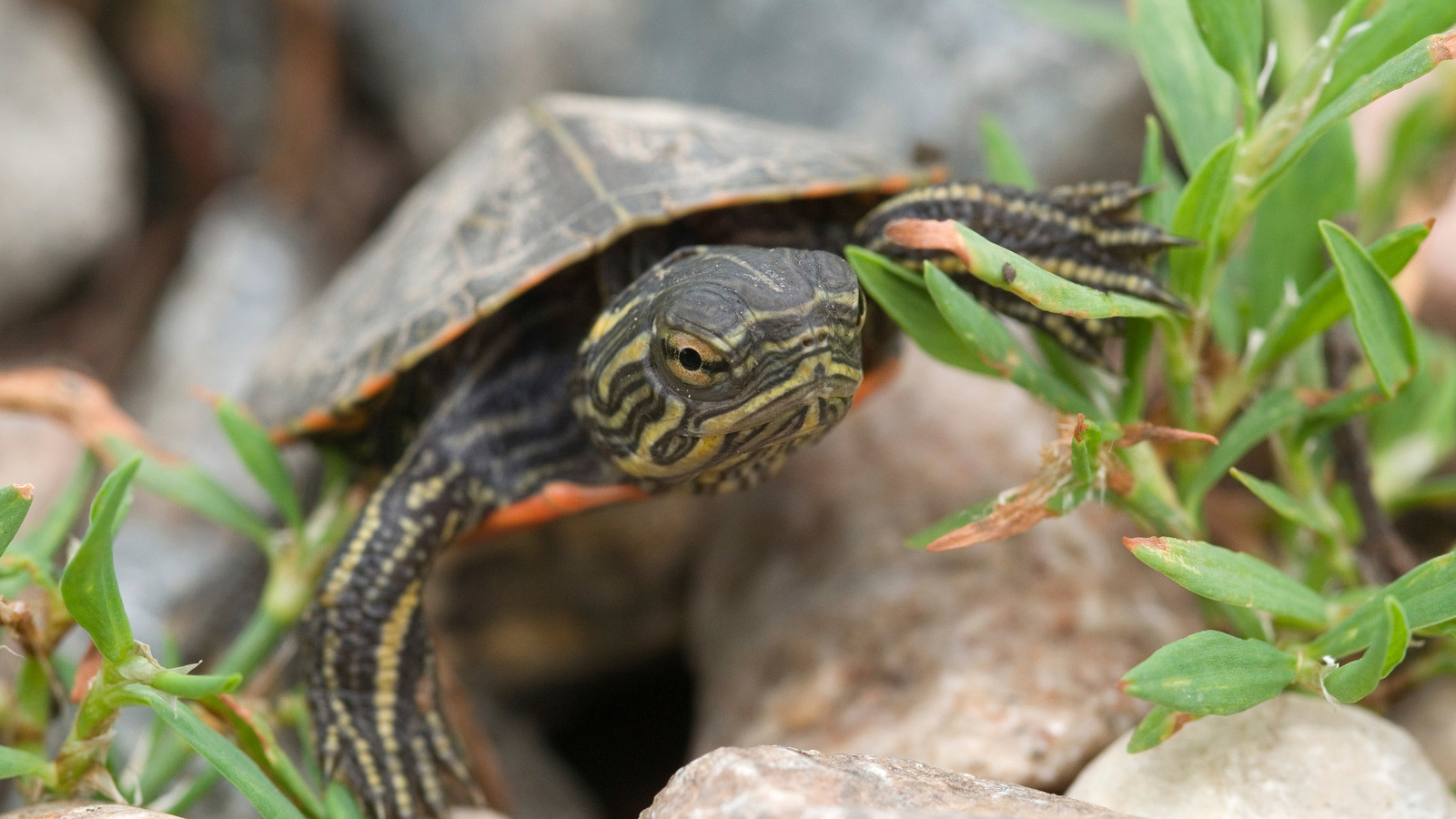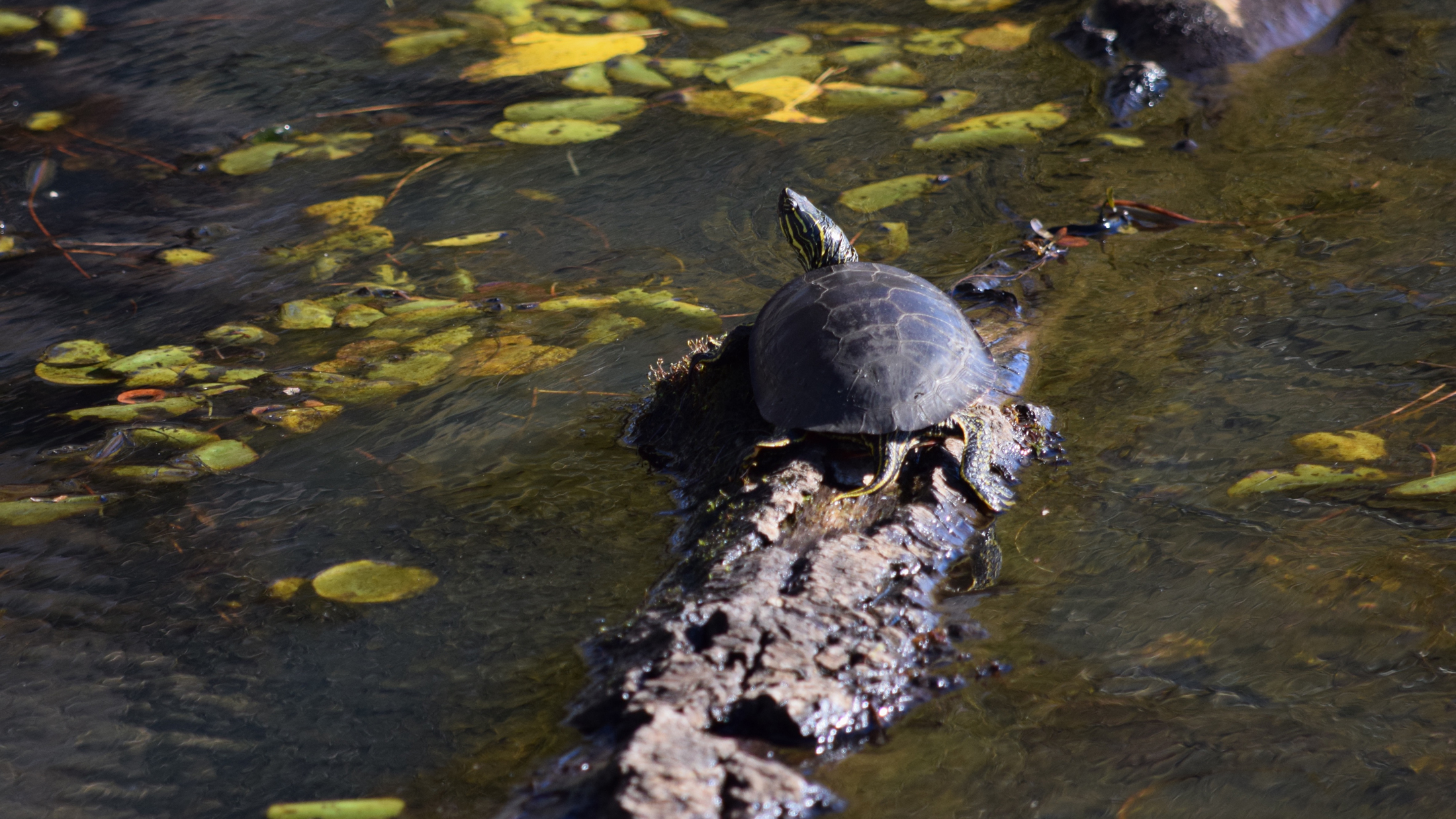Where are the turtles in cold months?
As ectotherms (or cold-blooded animals), turtles’ body temperature and metabolism are determined by external heat sources. When it’s cold enough outside, their metabolism slows down, so they aren’t active enough to forage.
Where do they go and how do they survive in cold winter weather? Turtle species exhibit a variety of incredible adaptations that allow them to live through extreme weather conditions.
While turtles, tortoises, and terrapins deal with winter in a variety of ways, undoubtedly the most extreme survivor is the painted turtle (Chrysemys picta). Let’s look at what makes the painted turtle the king of winter.
Painted turtles spend most of their time in ponds and slow-moving freshwater and a sheet of ice doesn’t stop them, it only slows them down. Even in the northernmost parts of their range, adults will overwinter under ice, sometimes buried up to 45 cm in the mud beneath the water.
“Sometimes when a pond freezes, you can see the turtles sitting on the bottom. If you cut through ice you’d think they were dead,” says Kurt Buhlmann of the University of Georgia. “It would take hours for them to move.”

Hatchling painted turtles emerge from their eggs in Autumn, but stay underground in the nest (on land) for the winter and emerge in the spring.
Lab experiments have shown that adults can survive for more than 100 days in water at 3°C without food or oxygen. In the wild, some northern turtles are dormant for up to six months, however, the conditions are variable – so they may have access to oxygenated water for part of the winter.
Painted turtles exist and survive in landscapes where winter temperatures can reach sub-zero temperatures.
How Do They Survive?
Painted turtles’ super survival powers rely on a system of adaptations and fallback plans.
At freezing temperatures, as low as -2°C, hatchling painted turtles in their nest can supercool (reach a freezing temperature without any crystallization) and remain in that state for about 3 days, possibly for longer and at lower temperatures if the soil is dry and they are desiccated. Most hatchlings studied in the lab recovered rapidly when warmed. If supercooling fails, for instance in moist soil, hatchlings may freeze (and crystallize), but if they are not frozen too long or at too low a temperature they are still able to thaw and recover.

Like all turtles, painted turtles have lungs and during warm months they get most or all their oxygen by breathing air. However, while submerged for the winter, they can absorb some oxygen through their skin, mouth and cloaca. Even more impressive, painted turtles can hibernate for months in hypoxic (low oxygen) and anoxic (no oxygen) environments. Most vertebrates can only live a matter of minutes without oxygen (the heart and nervous system fail).
The reduced metabolic rate of the painted turtle in winter — which is down from their normal metabolic rate by as much as 95% with access to oxygen and as much as 99% when there is no oxygen available — is, surprisingly, the key to their survival. Although it prevents them from being active, the low metabolic rate also reduces their energetic needs to a bare minimum, allowing them to survive without food or oxygen.
When I think of hibernation, I immediately think of bears – which rely on fat stores to get them through their winter dormancy. Fat stores, however, can only be used when oxygen is plentiful. To survive without oxygen, painted turtles break down glycogen. This process releases enough energy to keep them alive but also creates lactic acid, which can build up enough to be deadly (acidosis).
Painted turtles survive by changing their blood chemistry – borrowing materials from their skeleton and shell to balance out the acid. They can also store some of the lactic acid in their skeleton and shell.

Counterintuitively, painted turtles would not be able to survive if trapped underwater without oxygen in warm water. For instance, aquatic turtles of all species, from painted turtles to sea turtles are subject to drowning when trapped underwater in fishing nets. Their metabolism is elevated as the water warms, increasing their energetic needs and therefore the amount of acid that builds up in their system, overloading the turtles’ safeguards.
Winter Conservation Needs
Sometimes you can see turtles under the ice. If you do, enjoy observing them, and know they are fine. Please don’t break the ice!
The ice provides a buffer between the turtle and the colder air above, if you pull them out they might freeze. There are limits to their ability to survive in freezing temperatures and you may unintentionally harm their chance at survival.

You can also advocate for the protection of the ponds, lakes, and streams that these turtles call home year round.
“One critical thing for overwintering turtles in ponds and wetlands,” Buhlmann explains, “don’t change water levels in the middle of winter. If wetlands are managed for waterfowl and the water is drained because the birds are gone, the hibernating turtles sitting on or in the mud are exposed to freezing temperatures and it will kill them. So, if you change water levels in a wetland where turtles are known residents, you need to plan it out so that it’s safe for turtles. Think about making sure wetlands aren’t drained completely, and avoid the seasons of greatest temperature extremes.”




Great, but please elaborate on how embryos tolerate low O2 conditions while incubating underground while warm.
Dear Lisa:
Thank you for a fascinating article. I see that you enjoy mythology. When I was in middle school, I feel in love with it after reading the “Illiad”. I became quite an expert. Unfortunately, I’ve forgotten a lot of what I knew.
Sincerely,
Carlos Cabezud
I was just wondering about this the other day. Thank you
I learned something new today. Very interesting.
FASCINATING
When I was a lad, I had a “pet” painted turtle that I kept in a wooden stave barrel. One fall/winter the water froze to the bottom and when the water thawed (not sure how many weeks/months later) the turtle crawled out and seemed quite well in spite of its frozen hiatus! Didn’t anticipate it then, but I eventually had a career in academic biology and ecology!
Thank you for the most interesting article. I always enjoy learning new things, especially involving Nature, and its inhabitants. I am a Vietnam Veteran living at the Illinois Veterans Home.
How interesting to find out things about animals that we never have known before. Thank you for the information.
Save all the Turtles.
I have a pet painted turtle, named Etta. She is 15 years old, and a really fascinating pet. I’m not surprised that Steven, below, says the turtle swam away swiftly! Anyone who says turtles are slow has never seen a painted turtle swim or crawl! Etta surprises me with her obvious intelligence, and manages somehow to get the most amusing expressions! She often refuses to eat for months in the winter, even though she isn’t cold, inside. It used to worry me, but after 15 years, I know that’s just Etta!
While working (biologist) on the Kootenai National Forest in the mid 1990’s, I met with several Canadian biologists that were studying amphibians and reptiles in wetland habitats located just north of the US/Canadian border. While looking at our wetland communities, one of the biologist mentioned a study they were doing on painted turtles. They had installed radio transmitters on a number of turtles and followed their movement under the ice during the winter. They mentioned that the turtles traveled quite a bit just under the ice. I had thought that the turtles basically were inactive in the mud shallows once the lakes/ponds froze over, which almost all do during the winter in this area (Lincoln County).
WE NEED TO SAVE THEM NOW
Always have liked turtles since I was a child.
Thank you, a very good nature lesson.
Grateful.
I live in Springfield in central Illinois. I travelled 80 miles south last Sunday to paddle my canoe on Carlyle Lake, east of Saint Louis. While I was paddling in the shallows I saw several turtle heads poking up out of the water. Of course as I approached they would dive, but I managed to see one resting on the bottom, and I saw another swimming away as swiftly as if temperatures were much more springlike than the 34 degrees F reported by the Weather Service. I would also like to note that the shallow areas of Lake Springfield, 80 miles to the north, were frozen at the time, and a sheath of ice had formed on the lower part of my paddle shaft there on Carlyle Lake. I don’t know what the water temperature was, but in 40 years of paddling and hiking around lakes and rivers this was a first. Just wondering, what water temperature is typically required for painted turtles to be that active?
Hi Steven, Thank you – that is a good question. Most of the studies I read were about turtles in the lab, so they showed the limits of a turtles capability to survive, but didn’t always reflect the variable conditions that turtles encounter in the wild. There was some speculation that when the water is warm enough and there is open ice, the turtles would surface occasionally to breathe and then would settle back to the bottom into a “torpor” or similar state. This would require a small amount of energy and replenish their oxygen supply – even though they can technically survive without oxygen, it is less of a strain on their system to function with oxygen.